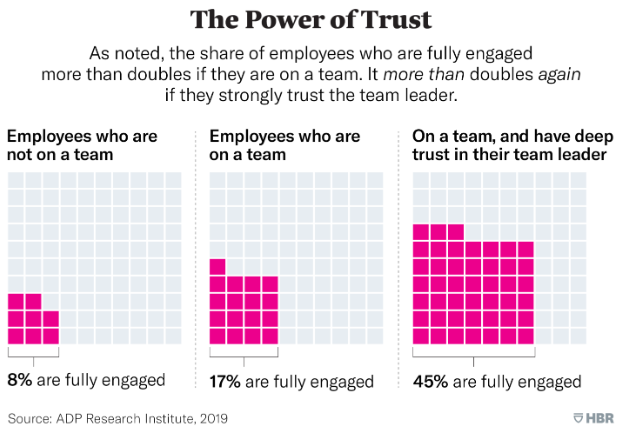
After reading The Power of Hidden Teams by Marcus Buckingham and Ashley Goodall on Harvard Business Review, I was compelled to share key insights. The article and supporting research provided surprising insights and actionable recommendations to address a passion of mine: employee engagement and retention. I hope you find as much value in reading the recap (or full article) as much as I have.
For years, companies have tried to improve employee engagement and performance through top-down culture initiatives or individual development programs. However, a massive global study by the ADP Research Institute reveals that the most powerful factor driving engagement is whether employees feel part of a team or not. Those working on teams were over twice as likely to be fully engaged compared to those working alone.
The traditional organizational chart obscures the reality that most work happens across dynamic, informal teams that are invisible to the company. Top-down goal cascades and performance reviews fail to align with how work is completed through these fluid team structures. To unlock higher engagement and productivity, organizations need to shift their focus to the team as the fundamental experience of work.
The authors identify five key principles for cultivating high-performing, engaged teams based on the research findings:
- Focus on trust. Team members who strongly trust their team leader are eight times more likely to be fully engaged. This deep trust is built when the leader clearly understands each person’s strengths and focuses their work to maximize those strengths.
- Design teams for human attention. The most engaging teams have team leaders who provide frequent, light-touch attention through weekly check-ins with each member to discuss priorities and needs. The optimal “span of control” is better defined as the “span of attention” that allows this regular cadence.
- Learn together. Rather than teaching teamwork skills in isolation, the most effective approach is team-based learning where each real team builds habits and rituals to accelerate their growth together through their actual work.
- Put team experience above location. Contrary to conventional wisdom, remote workers reported higher engagement than co-located workers. What matters most is feeling part of a supportive team, not physical proximity.
- Make all work more like gig work. The most engaging work structure combines a stable core role with a “side gig” allowing variety and passion projects. Organizations should provide this flexible model.

The evidence points to a needed shift in how organizations see and enable teamwork. Rather than a rigid hierarchy, companies should operate as an ecosystem of dynamic teams. HR should revamp practices like hiring, development, rewards, and career paths around this team-based model of work.
Most critically, leadership itself must be re-defined around the role of “team leader” – the job of masterfully orchestrating each person’s unique strengths through the experience they create for their team every day. Investing in team leaders as “quirk captors” may be the highest leverage opportunity to drive engagement, innovation, and performance.
Human Resources and senior executives would be wise to heed this research – the team-based operating model it prescribes may be the key to finally cracking the code on engagement in today’s fluid, team-driven world of work. Read the entire article on HBR.




